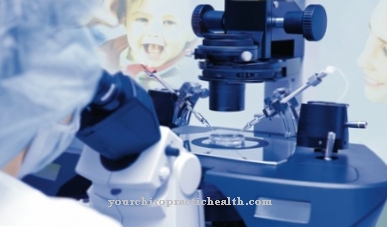The Lithium therapy is used for mood disorders and therapy-resistant schizophrenia. Lithium stabilizes mood and is the only known drug that has been shown to prevent suicide.
What is lithium therapy?
In the lithium therapy used in psychiatry, lithium is administered to stabilize mood. Lithium has been used as a medicinal substance in the context of psychiatry since the beginning of the 20th century.
Lithium therapy is the only therapy that can be used for mood disorders, e.g. B. in depression and bipolar disorder, has a suicide-preventive effect. Lithium is not administered by itself, but in the form of its salts. Lithium therapy is considered well researched and safe. In the correct dosage, lithium salts are well tolerated and effective. However, the exact mechanism of action of lithium therapy is not known.
Function, effect & goals
Lithium therapy is used for recurrent depression, recurring phases of mania and depression in the context of bipolar disorder and for treatment-resistant schizophrenia. Lithium is also used as a second-line drug for preventive treatment of cluster headaches.
In Europe, however, the administration of antiepileptic drugs to stabilize mood is preferred in psychiatry. In the USA, on the other hand, lithium therapy is much more widespread for the indicated indications. Lithium was first described as a psychiatric drug in 1949 by the Australian psychiatrist John F. Cade. He discovered the antimanic effect of the substance by chance in an animal experiment and then administered the substance to his manic patients and found an effect on them too. Until his death, Cade played a key role in the further development of lithium therapy.
The exact mechanism of action of the substance is not known to this day, despite the good research. It has only been proven that the salts of lithium change the functions of the body in many different places. It is generally assumed that the effectiveness of lithium therapy in the above-mentioned psychiatric illnesses is based on the fact that during a manic episode the lithium reduces an excess of noradrenaline, whereas the production of serotonin is stimulated during depressive episodes. The lithium therapy, if it is carried out over a longer period of time, can lead to a balance of the mood of the patient.
The assumption seems conclusive insofar as the effects of lithium can be logically explained by the regulating and balancing effect. A final proof that the effect actually results from the processes mentioned has not yet been provided. The therapeutic range, i.e. the range between the effective and the harmful dose, is narrow with lithium. For this reason, self-implementation of lithium therapy is clearly not advisable. Furthermore, the concentration of lithium in the blood must be checked regularly during therapy in order to rule out an overdose.
Absolute contraindications are acute myocardial infarction, pronounced hyponatremia (insufficient sodium concentration in the blood), severe renal insufficiency, acute kidney failure and severe heart failure. In addition, there are relative contraindications in pregnancy and in the presence of Addison's disease (adrenal insufficiency). There are some findings on the implementation of lithium therapy during pregnancy.
Since malformations frequently occurred in newborns after lithium therapy during pregnancy, lithium salts were considered teratogenic (teratogenic) and their use during pregnancy was not recommended in order not to endanger the unborn child. Today it has been recognized that lithium therapy in pregnancy is indeed risky, but should not be ruled out in every case. The diseases that can be treated well with lithium therapy can also be dangerous for the unborn child.
The risk of malformations in newborns has been shown to be five to ten times higher after lithium therapy in pregnant women. As a guideline, a very strict indication applies today; a desired consistently low serum concentration of lithium, for which a dose adjustment is necessary; a dose reduction in the week of childbirth; monitoring of the newborn for symptoms of poisoning and, if therapy is given in the first trimester of pregnancy, ultrasound diagnostics and echocardiography of the fetus.
Lithium is the only drug that has been shown to reduce the risk of suicide in mood disorders. In addition, a group from the University of Vienna has shown that the suicide rate in regions with a high concentration of lithium in drinking water is lower than in regions with a low concentration of the substance in drinking water.
You can find your medication here
➔ Medication to lighten the moodRisks, side effects & dangers
Lithium therapy, like any other drug therapy, is associated with certain risks. Some more or less serious side effects can occur as part of the therapy. Weight gain, circulatory disorders, tremors especially in the hands, nausea, vomiting, changes in the blood count (leukocytosis), tiredness, increased thirst and urination, diarrhea and an underactive thyroid are typical side effects of lithium therapy.
If the therapeutic dose is exceeded, drowsiness, convulsions and coma can occur. Since the therapeutic range of the drug is narrow, regular monitoring of the serum level is recommended in order to reduce the risk of such complications. Long-term use can lead to diabetes insipidus, acidosis (over-acidification of the blood) and so-called lithium nephropathy with impaired kidney function, even in therapeutic doses.
Ibuprofen, diclofenac and other NSAIDs and ACE inhibitors interact with lithium in that they inhibit the excretion of the substance. Lithium is not addictive. However, tapering off is necessary to avoid side effects of discontinuation.
























.jpg)

.jpg)
